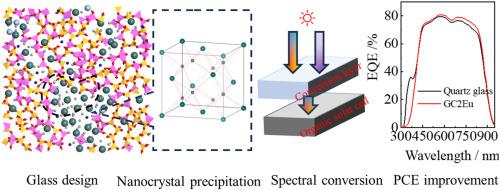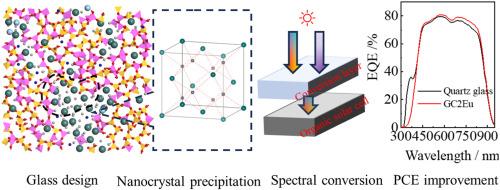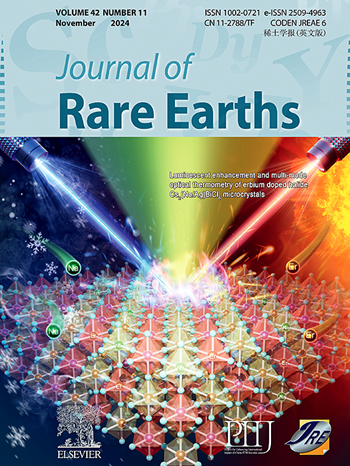掺杂 Eu 的多组分透明光谱转换玻璃陶瓷的分子动力学模拟途径
IF 7.2
1区 化学
Q1 CHEMISTRY, APPLIED
引用次数: 0
摘要
含有 BaF2 纳米晶体的 Eu2+ 掺杂氟硅酸盐玻璃陶瓷作为有机太阳能电池的光谱转换材料具有很大的潜力。然而,传统的试错玻璃制备方法很难实现 BaF2:Eu2+ 掺杂氟硅酸盐玻璃的高效设计,也很难在实验中生动观察玻璃的微观结构。通过分子动力学(MD)模拟方法预测、设计和制备了具有高透明度和高光致发光(PL)性能的掺杂 BaF2:Eu2+ 氟硅酸盐玻璃陶瓷。通过 MD 模拟预测,实现了自组织纳米结晶,抑制了氟氧化物界面中形成的 [AlO4] 四面体导致的纳米晶体异常生长。NaF 的引入降低了玻璃的有效声子能,因为 Na + 会促使 Al3+ 从氟化物相迁移到硅酸盐相和界面。通过预测 EuF3 的掺杂浓度,优化了 Eu2+ 的局部环境,在这项工作中,2 mol% EuF3 是最佳浓度。作为光谱转换层的玻璃陶瓷样品 GC2Eu 成功地应用于有机太阳能电池,获得了更多可用的可见光声子和更高的光电转换效率(PCE)。这项工作证实了分子动力学模拟方法对氟硅酸盐玻璃设计的指导作用。本文章由计算机程序翻译,如有差异,请以英文原文为准。


A molecular dynamics simulation route towards Eu-doped multi-component transparent spectral conversion glass-ceramics
Eu2+ doped fluorosilicate glass-ceramics containing BaF2 nanocrystals have high potential as spectral conversion materials for organic solar cells. However, it is difficult to realize the efficient design of BaF2:Eu2+ doped fluorosilicate glass and to vividly observe the glass microstructure in experiment through traditional trial-and-error glass preparation method. BaF2:Eu2+ doped fluorosilicate glass-ceramics with high transparency, and high photoluminescence (PL) performance were predicted, designed and prepared via molecular dynamics (MD) simulation method. By MD simulation prediction, self-organized nanocrystallization was realized to inhibit the abnormal growth of nanocrystals due to [AlO4] tetrahedra formed in the fluoride-oxide interface. The introduction of NaF reduces the effective phonon energy of the glass because Na+ will prompt Al3+ to migrate from the fluoride phase to the silicate phase and interface. The local environment of Eu2+ is optimized by predicting the doping concentration of EuF3 and 2 mol% EuF3 is the best concentration in this work. Glass-ceramics sample GC2Eu as spectral conversion layer was successfully applied on organic solar cells to obtain more available visible phonons with a high photoelectric conversion efficiency (PCE). This work confirms the guidance of molecular dynamics simulation methods for fluorosilicate glasses design.
求助全文
通过发布文献求助,成功后即可免费获取论文全文。
去求助
来源期刊

Journal of Rare Earths
化学-应用化学
CiteScore
8.70
自引率
14.30%
发文量
374
审稿时长
1.7 months
期刊介绍:
The Journal of Rare Earths reports studies on the 17 rare earth elements. It is a unique English-language learned journal that publishes works on various aspects of basic theory and applied science in the field of rare earths (RE). The journal accepts original high-quality original research papers and review articles with inventive content, and complete experimental data. It represents high academic standards and new progress in the RE field. Due to the advantage of abundant RE resources of China, the research on RE develops very actively, and papers on the latest progress in this field emerge every year. It is not only an important resource in which technicians publish and obtain their latest research results on RE, but also an important way of reflecting the updated progress in RE research field.
The Journal of Rare Earths covers all research and application of RE rare earths including spectroscopy, luminescence and phosphors, rare earth catalysis, magnetism and magnetic materials, advanced rare earth materials, RE chemistry & hydrometallurgy, RE metallography & pyrometallurgy, RE new materials, RE solid state physics & solid state chemistry, rare earth applications, RE analysis & test, RE geology & ore dressing, etc.
 求助内容:
求助内容: 应助结果提醒方式:
应助结果提醒方式:


